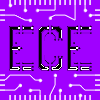First, the scalar or dot product of two vectors, which results in a scalar.
And secondly, the vector or cross product of two vectors, which results in a vector.
In this tutorial we shall discuss only the scalar or dot product.
The scalar product of two vectors, A and B denoted by A·B, is defined as the product of the magnitudes of the vectors times the cosine of the angle between them, as illustrated below:
Note that the result of a dot product is a scalar, not a vector.
The rules for scalar products are given in the following list:
And in particular we have:
Alternatively, we have , since the angle between X and Y is 90º and the cosine of 90º is 0.
In general then, if A·B = 0 and neither the magnitude of A nor B is 0, then A and B must be perpendicular.
The definition of the scalar product given earlier, required a knowledge of the magnitude of A and B , as well as the angle between the two vectors. If we are given the vectors in terms of a Cartesian representation, that is, in terms of X and Y, we can use the information to work out the scalar product, without having to determine the angle between the vectors.
If
then
Because the other terms involved,
Let us do an example. Consider two vectors,
 and
and  . Now what is the angle between these two vectors?
. Now what is the angle between these two vectors?- From the definition of scalar products we have
 .
.- But
 .
.- Source: physics.uoguelph.ca
If you are still having a difficulty in understanding the dot product, then watch this:













0 people rectified:
Post a Comment